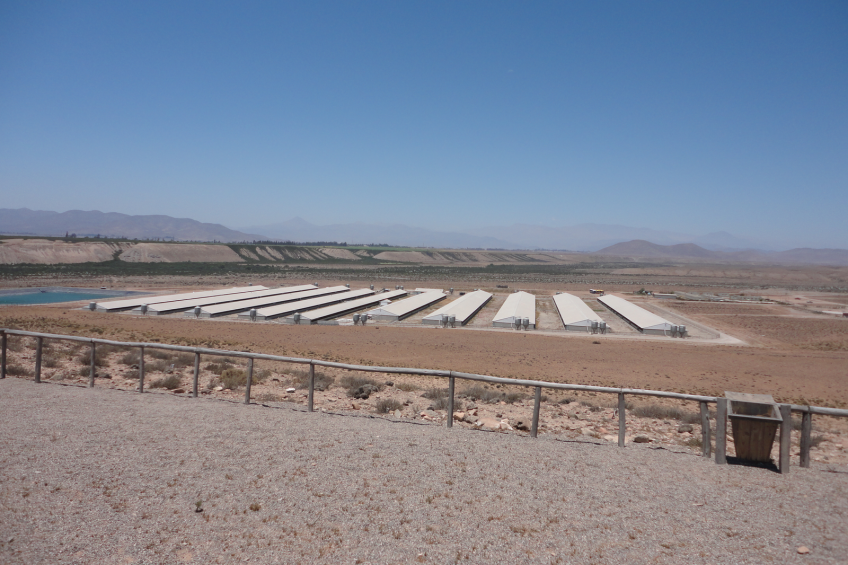Chile’s pork engine is slowing down

In the last decade, Chile’s pork industry has seen considerable growth in both production and exports. Recently, however, the Chilean industry has noticed some setbacks which include ?higher feed costs and veterinary problems.
For more than ten years the Chilean pork industry experienced a positive flow. Pork production grew with over 200,000 tonnes of carcass weight, to 575,000 tonnes in 2014. Production growth started to grow about 15 years ago. At that time, the country counted about 400 pork producers. Strong consolidation, especially in the last six to seven years, resulted in the current 220,000 sows being owned by 40 companies.
With such a limited amount of players, the Chilean pork industry is relatively easy to understand. Five companies have taken the lead in pushing the industry forward. Most well-known is Agrosuper, an integration topping most lists having approximately 120,000 sows. This number could have even been subtantially higher had neighbours not complained against a large farm in Freirina, also see box on opposite page.
Even the farms outside these top-5 are quite sizable, often with several thousands of sows and their successive finishers.
High production
Pig production and Chile have turned out to be a good combination. On average pig farms achieve 27 to 28 slaughter pigs per sow per year, explains Raúl Faggiani, an Argentinian, and working as sales manager Latin America for Koudijs Animal Nutrition, part of international feed company De Heus.
In terms of production costs, labour force is not a large limitation in Chilean farms as wages are relatively low and only few restrictions exist with regard to antibiotic use. Nevertheless, Faggiani points to lower antibiotic use in Chile than in e.g. Mexico and Brazil, the other pork powerhouses in Latin America. The use of growth promoter ractopamine is not allowed in Chile.
Large proportions of feed are imported. Soybeans are mostly trucked in from Argentina; about half of the grain demand is also imported.
High-end markets
Increasingly, Chile has proven itself to become a main player in the global meat market. Table 1 shows that just like production, exports are also growing. For 2014, an export volume growth of 190,000 tonnes carcass weight is forecasted. Another important importing nation is Japan, purchasing just over one third of Chile’s pork exports. In addition, a large quantity is being shipped to South Korea. Both markets are looking for high quality meat products.
China is likely to join their ranks again. Early August, China approved an electronic certification system, allowing an easier approval process between the two countries, the Pork Producers Trade Association of Chile (Asprocer) reported. For about a year, the Chinese had ceased importing Chilean pork due to suspicion of dioxins being present in the meat. China had imported about 6% of all exports in 2013.
Despite the Chilean pork industry’s fast growth in the last decade, the country’s growth in pork production is only marginal on a global scale. Its importance for South Korea and Japan, however, has not gone unnoticed.
The Chilean pork industry has recentlyexperienced some setbacks. Prices for animal feed raw materials have gone up, also see box, market leader Agrosuper was forced to abandon a huge project and since 2013, Chile’s herd has suffered from Porcine Reproductive and Respiratory Syndrome (PRRS). This virus is relatively new to Chile and has put a pressure on technical results. For now, no PRRS vaccines are allowed in Chile. The Porcine Epidemic Diarrhoea virus (PEDv) outbreaks have not got as far south as Chile.
Nevertheless, the Chilean pork sector is strong. Companies are professional, people work hard and the sector has been developing itself rapidly. Quitting is certainly no option for the larger Chilean firms – they will pick themselves up again.
Neighbourhood protest
In 2012, the town of Freirina, in Chile’s northern Atacama region, made world headlines when residents revolted against the presence of a 500,000 pig-large complex which included a slaughterhouse. The complex, owned by Chile’s largest pork producer Agrosuper, produced a strong and unpleasant smell, leading to mass demonstrations and road blocks, making feed transport difficult. In May of that year, authorities declared a health alert and temporarily closed the plant, leading to death of the pigs due to starvation and lack of water. When it was allowed to reopen in December of that year, anger quickly grew again. Agrosuper then decided to close the complex permanently, stating: “The recent environmental rating substantially restricts our operation, leaving us a limited economic viability. This and the recent events, which we regret, have led the company to take this decision.” The government eventually had no choice but to slaughter all the animals. Currently the farm is now dismantled. Life standards, employment and infrastructure in the area are relatively good; people can get by without the farm.











